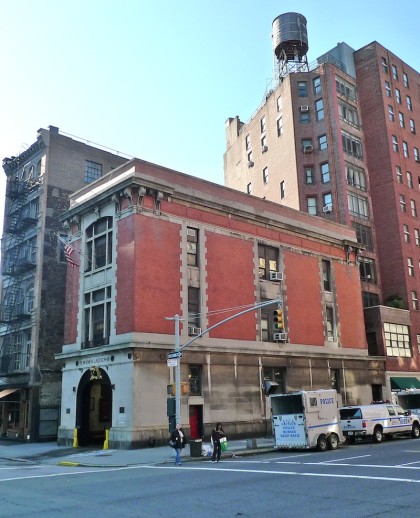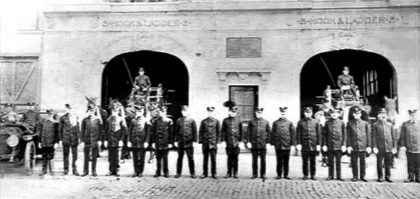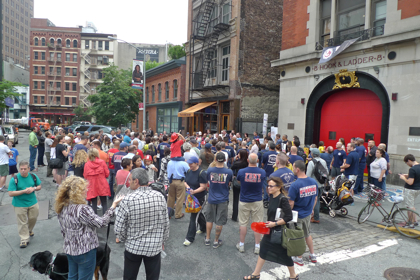The History of 14 N. Moore
 Tom Miller, who writes about the history of Manhattan buildings at Daytonian in Manhattan, has allowed Tribeca Citizen to create a database of his Tribeca posts. If you enjoy these, and you will, then you should definitely check out his website, which also has write-ups about buildings all over the island. And don’t miss his book, Seeking New York: The Stories Behind the Historic Architecture of Manhattan—One Building at a Time.
Tom Miller, who writes about the history of Manhattan buildings at Daytonian in Manhattan, has allowed Tribeca Citizen to create a database of his Tribeca posts. If you enjoy these, and you will, then you should definitely check out his website, which also has write-ups about buildings all over the island. And don’t miss his book, Seeking New York: The Stories Behind the Historic Architecture of Manhattan—One Building at a Time.
··································
 In 1866, Hook and Ladder Company No. 8 moved from Franklin Street to 7 N. Moore Street, where it remained for nearly a half century. After the consolidation of the five boroughs of New York in 1898, the Metropolitan Fire Department was reorganized into the New York City Fire Department.
In 1866, Hook and Ladder Company No. 8 moved from Franklin Street to 7 N. Moore Street, where it remained for nearly a half century. After the consolidation of the five boroughs of New York in 1898, the Metropolitan Fire Department was reorganized into the New York City Fire Department.
On February 5, 1904, the Sinking Fund Commissioners met and discussed the issue of erecting a new fire station for Hook and Ladder Company No. 8. The property at the southeast corner of N. Moore and Varick Streets, where the old North Moore Street School stood, was appropriated for the purpose.
Until 1895, the fire stations had been designed by the architectural firm of Napoleon LeBrun & Sons; but with its reorganization, the fire department now had its own in-house architect, Alexander H. Stevens. Stevens received the impressive title of Superintendent of Buildings.
The Hook and Ladder Company No. 8 would be one of his first designs. A “double company” facility, it was a handsome brick and limestone structure with two great matching arched truck entrances opening onto N. Moore Street. Above each entrance the high second and third story windows were encased in a limestone framing. Carved stone scrolled brackets supported the plain cornice. Each truck entrance was embellished with an ornamental, Baroque cartouche.
For decades Hook and Ladder Company No. 8 had distinguished itself with awards. In 1914, Capt. John E. Farley accepted the John T. Stephenson Medal for maintaining the highly-efficient company during 1913.
 Firefighters pose before the station before it was cut in half.
Firefighters pose before the station before it was cut in half.
··································
That same year the Company received surprising news regarding its ten-year old building. A year earlier the city’s Board of Estimate and Apportionment had begun the $3 million project of widening Varick Street by 30 feet and connecting it to 7th Avenue. The project would increase the width of Varick Street to 100 feet.
More than 200 buildings stood in the way of the expansion, among them the majestic 1807 Georgian-style St. John’s Chapel as well as Hook and Ladder Company No. 8. The Fire Department looked at property across the street as a site for a replacement building.
But then Fire Commissioner Robert Adamson made a surprising decision: the fire house would simply be cut in half.
The cost to buy the site across the street would be $110,000 and the cost of razing the existing building would add another $25,000. But by simply reducing the double company to a single one and renovating the structure to half its size, the total cost was reduced to $20,000.
The alterations to the building were astonishingly invisible. The limestone cornices, the carved stone brackets, the window treatment were all deftly copied so that the casual passerby is given no clue of the change.
Fireman John Walsh brought accolades to the company when on October 25, 1916, he did what the Fire Department deemed “the most daring act performed in three years.” The factory building at 21-25 E. Houston Street was engulfed in flames and working girls were trapped inside. One, Ida Goldberg, appeared in a seventh story window with no way out.
Walsh hung his scaling ladder from the cornice of an adjoining building and, by “swinging like a pendulum was able to grab the girl by the arm. Though a slip meant death, he brought her to safety,” praised The New York Times. Commissioner Adamson called the action “one of the finest rescues in the history of the New York Fire Department. Walsh was awarded a Medal of Valor by the mayor.
While Walsh remained home fighting fires, Fred J. G. Wedemeyer left to fight the war in France. Two years after Walsh’s award, Mayor Hylan decorated Wedemeyer for meritorious acts performed with the army in 1917. Sadly, on June 10, 1952, Fireman First Grade Frank E. Wolf’s Department Medal was awarded posthumously.
It would not be the many meritorious acts of the fireman of Hook and Ladder Company No. 8 that would bring the building fame, however. In 1984, the firehouse was used as the exterior of Ghostbusters headquarters. Because it was still an active firehouse, a decommissioned station in Los Angeles was used for the interior shots. But film buffs recognize the Tribeca firehouse, which was used again in the 1989 Ghostbusters II, and flock there to take photographs.
On the morning of September 11, 2001, Hook and Ladder Company No. 8 responded to the murderous attack on the World Trade Center buildings. Lt. Vincent G. Halloran would not return that day. In 2005, a movement was begun to consider renaming the block along North Moore Street between Varick and W. Broadway for Lieutenant Halloran.
In the spring of 2011, Mayor Michael Bloomberg included Hook and Ladder Company No. 8 on his list of 20 fire houses slated to close in a money-saving thrust. The Tribeca community responded with an outpouring of frustration and anger. In June, a crowd of over 100 residents, politicians and firefighters assembled to protest the projected closing (pictured below).
The half-a-firehouse at 14 N. Moore Street is still active, although that situation could change. In the meantime, the dignified structure that was once twice its size provides an interesting footnote in Tribeca and FDNY history.
··································
Photo credits from top: Tribeca Citizen; unknown; Tribeca Citizen.













